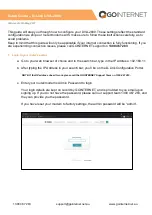
FRITZ!Box Fon WLAN 7113
110
Glossary
use the Internet connection. If the TCP/IP setting is
configured by means of a DHCP server, there is no need to
enter the gateway address manually.
IP
abbreviation for Internet Protocol
The IP Internet Protocol is the most important basic
protocol for the control of data exchange in local networks
and in the Internet. The Internet protocol works without a
connection; in other words, data packets are transmitted
from the sender to the recipient without previous
consultation. The addresses of the recipient and the
sender in the data packets are given as IP addresses.
IP address
abbreviation for Internet Protocol address
In IP-based networks, for instance in the Internet and local
networks, all connected devices are addressed via their IP
addresses. So that data packets are sure to be delivered
to the right address, each IP address may be assigned
only once within the Internet or a local IP network.
The IP address consists of four three-digit groups of
numbers (for instance, 192.168.178.247). Each group of
numbers can assume values between 000 and 255.
Every IP address contains two components: the network
address and the host address. These two components can
be read out of an IP address only if the subnet mask is
also specified.
IP addresses can be public or private, and also fixed or
assigned dynamically. See the corresponding entries in
the Glossary for more information.
IP addressing
Addressing is one of the main functions of the Internet
Protocol (IP). Internet addresses can be written in
decimal, octal or hexadecimal notation. The FRITZ!Box
uses "dotted-decimal" notation: The four bytes of an
address are represented by decimal numbers separated
by dots. The total volume of Internet addresses, the
address space, is separated into classes (A, B, C, D, and
E). The full set of IP addresses, called the address space,













































